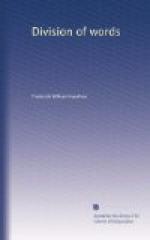Ordinarily the difficulty has been met by dividing words and putting a part of a word on one line and the rest of it on another, indicating the break by a hyphen. The hyphen in such a case is always the closing character in the first line. Clearly this division must be so made as to assist the reader in his task. The primary purpose of all printing is to be read. Anything that adds to the legibility of the printing improves it; anything that detracts from its legibility harms it. How can we so divide words that the legibility and intelligibility of the text will be maintained, the line justified to register, and the beauty of the page enhanced? These ends—legibility, intelligibility, and beauty—are the aims of all the rules which have been devised for the division of words. These are the things the reader will see and by them he will judge the results. He will probably know nothing about the rules by which the compositor gains his results. The compositor needs to know the rules, but to remember always that they are only means by which to secure results.
There have been several attempts to devise systems of division, but no one of them is thoroughly consistent or universally adopted.
One system requires the division of a word when the pronunciation will permit on the vowel at the end of the syllable. It has the defect of making no provision for syllables that end in consonants. Moreover, if rigorously applied it would give us such divisions as ca-pa-ci-ty, cata-stro-phe, lexi-co-gra-pher, pre-fe-rence, pro-gno-sti-cate, and re-co-gnize.
Another system requires the division of consolidated words at the junction of their elements, for example:
magn-animous cata-clysm found-ation oceano-graphy theo-logy know-ledge lexi-co-grapher in-fer-ence pre-judice pro-gnos-ticate pro-position typo-graphy
In some cases this rule would lead to queer looking divisions. More serious objections are that the system does not provide for words that are long enough to be divided but are yet not consolidated words, and, most of all, that the average compositor is not an accomplished etymologist and knows very little about the derivation, make up, and compounding of the words he has to set up. He may be familiar, for example with the word rheostat, but it would puzzle him to tell from what language it is derived, while the word enclave would probably send him to the dictionary for meaning as well as derivation, unless he happened to be used to one particular kind of writing.
Another system, and probably on the whole the best one, requires the division of the word on the accented syllable.
theol-ogy catas-trophe geog-raphy lexi-cog-rapher pref-erence prog-nos-ticate
It will be noted that some of these examples show division in more than one place, that is on the syllables which bear either the primary or the secondary accent. This rule does not provide for the cases when the division must come on an unaccented syllable. The cases, however, when the division cannot be made to come on either the syllable bearing the primary accent or one bearing a secondary accent will be comparatively few.




